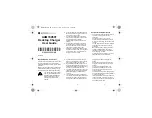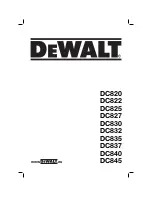
• Do NOT continue to charge LiPo/Li-Ion cells if they do not recharge
within the specified charging time. Failure to follow this guideline
could cause the battery to become hot, explode, or ignite.
• LiPo/Li-Ion cells should be charged about once per year at a
minimum to prevent over-discharge.
• LiPo/Li-Ion batteries should be stored with about 30%-50%
of capacity.
It is strongly recommended to only use LiPo/Li-Ion cells which have
obtained UL1642 approval to ensure they have been produced in
accordance with specific safety criteria. It is also strongly
recommended to use UL approved cells which have been assembled
with a charge protection circuit built into the pack. Such circuits help
to regulate cell operation to make sure they operate within specified
current and voltage limits. Batteries not containing a built-in regulative
circuit can accidently be overcharged, thus posing significant risk of
fire and/or explosion.
Consult your battery supplier if you are
unsure if your LiPo/Li-Ion battery has UL1642 approval or
includes a built-in protection circuit.
It is strongly recommended to set the charge current at a LOW
value for LiPo/Li-Ion batteries for safety purposes. Set the
charge current to NO GREATER than the battery’s 1C rating.
For example, charge a 600mAh battery at 0.6A, a 900mAh
battery at 0.9A, etc. Closely monitor the temperature of the
cells during charge. If cells become excessively warm to the
touch or begin to swell during charge remove them from the
charger immediately, and reduce the level of charge current for
future charges to prevent cells from overheating.
If desired to use as a stand-alone charger, a rear enclosure is included
with Quick Field Charger MkII to protect all internal circuitry from
possible damage from external forces. The physical shape and size of
Quick Field Charger MkII’s faceplate match that of a regular power
panel. This makes it very easy for mounting the charger directly into a
field box. Before removing the rear enclosure for field box mounting,
please remove the fuse from the rear enclosure. Next simply remove
the rear enclosure from Quick Field Charger MkII, then mount the face
panel directly into the pre-cut power panel hole on the field box (minor
adjustments to field box may be necessary). Remember to insert the
fuse back into the face panel once the Quick Field Charger MkII has
been properly mounted in the field box. Failure to replace the fuse will
cause the Quick Field Charger MkII to be inoperable.
Quick Field Charger MkII only accepts DC input power which could
come from a power supply or 12V automotive battery. Do not
attempt to apply more than 15V to the input, as permanent damage
to the charger could result and void the warranty. Applying less than
11V to the inputs will not be sufficient power to allow the charger to
work properly. Securely connect the charger’s red alligator clip to the
positive (+) terminal on the power source and the black alligator clip
to the negative (-) terminal. It’s best to use a clean DC power source
whose output is filtered to remove unwanted electrical noise. To
achieve maximum potential, the power source must be capable of
delivering at least 3 amps of current while maintaining 12 volts DC.
Turn off the power switch when not in use.
WARNING! Make sure the charger’s positive (+) and negative (-)
input connections are never accidentally shorted together
when connected to 12V DC power. Failure to do so could result
in permanent damage to the power source and the charger.
Power:
The main on/off POWER button is located on the far left. The
red LED will illuminate when the switch is turned to the “ON” position.
Two Charge Ports:
Each of Quick Field Charger MkII’s charge
circuits or “ports” contain two sets of banana jacks. One set of jacks
is marked “BATT” for connection of the battery to be charged. The
second set of jacks marked “METER” is for connecting an external
voltmeter for monitoring battery voltage during charge if so desired.
Controls:
Each charge port includes one red current adjustment dial
and one yellow pushbutton. Each red dial adjusts the charge current
for its respective charge port. Each pushbutton is used to initiate the
charge process for its respective port and can be used to manually
halt a charge process that is currently under way (if desired).
Two totally independent charge circuits are built into this charger,
noted as “CHARGER 1” and “CHARGER 2.” Each port is capable of
charging batteries containing from 1 to 8 NiCd or NiMH cells in
series, or 1-3 LiPo or Li-Ion cells in series. Therefore, both ports can
charge 4 or 5 cell receiver batteries, 8 cell transmitter batteries,
single cell glow ignitor batteries – even 6 or 7 cell batteries for park
flyer aircraft. This convenient feature means that no one port is
dedicated strictly for transmitter or receiver batteries.
Each port has adjustable current ranging from 200mA (great for
charging small cells) up to 2.0 amps (for charging larger size cells).
Low charge currents are more gentle on batteries and tend to result
in more accurate, full charges but take longer to fully charge
batteries. Smaller cells, such as “AAA” size cells and smaller can
easily overheat when charged with excessive charge currents and
therefore should only be charged at low rates. High charge currents
result in much quicker charge times, but are more stressful on
batteries which can shorten their overall lifespan. Larger cells, such
as “AA” and “A” size can handle higher charge currents, but battery
temperature should be monitored during the charge process to
make sure the battery does not overheat.
NiCd and NiMH Batteries:
Nickel-cadmium and nickel-metal hydride
batteries are charged using the peak detection method. This method
is more reliable than the “peak prediction” technique used by some
chargers and can result in a battery safely receiving approximately
95-98% full charge, after which time the charger will automatically
switch to a gentle trickle charge current. Trickle charge will help the
battery safely reach its 100% full charge potential.
LiPo and Li-Ion Batteries:
The “constant current/constant voltage”
method is used for charging LiPo and Li-Ion batteries. As the battery
approaches full charge the charger will recognize a reduction in charge
current – which is how LiPo/Li-Ion batteries naturally react when fully
charged – and will halt the fast charge process. Battery manufacturers
do not recommend applying a trickle charge to LiPo/Li-Ion batteries,
thus no trickle charge is available. See the
“Important Warnings
Concerning Use Of Lithium-Polymer And Lithium-Ion Batteries”
section on this page before charging LiPo/Li-Ion packs.
TO CHARGE A BATTERY:
It is highly recommended to use pre-assembled charge leads to
avoid possible erroneous operation as a result of using poor quality
connections. Always connect the charge lead to the charger first.
Then connect the battery to the charge lead.
WARNING! Do not short the battery connections, as
permanent damage to the battery and/or the charger could
result and void your warranty. Do not attempt to charge a
battery through the meter jacks.
Select a charge port. Securely connect the battery to be charged to the
“BATT” jacks, with the positive (+) battery lead connected to the red
jack and the negative (-) battery lead to the charger’s black jack. Set
CHARGING BATTERIES
BATTERY CONNECTION AND CHARGER CONTROLS
INPUT POWER
MOUNTING
IMPORTANT WARNINGS CONCERNING USE OF
LITHIUM-POLYMER AND LITHIUM-ION BATTERIES
2






















